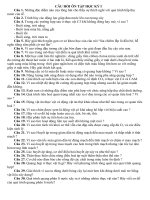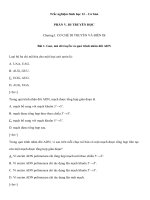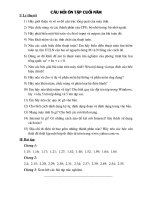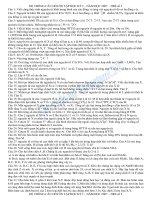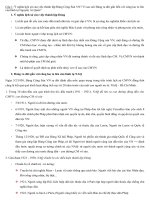CÂU HỎI ÔN TẬP CUỐI KỲ MÔN CÔNG NGHỆ PHẦN MỀM
Bạn đang xem bản rút gọn của tài liệu. Xem và tải ngay bản đầy đủ của tài liệu tại đây (1 MB, 176 trang )
TRƯỜNG ĐẠI HỌC KHOA HỌC TỰ NHIÊN
CÂU HỎI ÔN TẬP CUỐI KỲ MÔN CÔNG NGHỆ PHẦN MỀM
(LƯU HÀNH NỘI BỘ)
Q. 1: How many test cases are required to cover 100% 0 - switch coverage
respectively from X2?
D. 2
Q. 2: From a Testing perspective, what are the MAIN purposes of Configuration
Management?:
i) Identifying the version of software under test.
ii) Controlling the version of testware items.
iii) Developing new testware items.
iv) Tracking changes to testw are items.
v) Analysing the need for new testware items.
DA ->>C. i, ii and iv.
Q. 3: Which of the following is a MAJOR task of test planning?
DA ->>A. Scheduling test analysis and design tasks
Q. 4: Based on the IEEE Standard for Software Test Documentation (IEEE Std
829 - 1998), which of the following sections are part of the test summary report?
a) Summary
b) Test incident report identifier
c) Test deliverables
d) Risks and contingencies
e) Variances
f) Approvals
g) Output specifications
A. a, e and f
Q. 5: Which is a potential product risk factor?
D. Poor software functionality
Q. 6: Who typically use static analysis tools?
B. Developers and designers
Q. 7: Who would USUALLY perform debugging activities?
A. Developers.
Q. 8: Which of the following would you NOT usually find on a software incident
report?
C. Suggestions as to how to fix the problem.
Q. 9: Which of the following defines the expected results of a test?
A. Test case specification.
Q. 10: Some tools are geared more for developer use. For the 5 tools listed,
which statement BEST details those for developers
i) Performance testing tools.
ii) Coverage measurement tools.
iii) Test comparators.
iv) Dynamic analysis tools.
v) Incident management tools.
B. ii. and iv. are more for developers.
Q. 11: Which of the following is correct?
D. Impact analysis assesses the effect of a change to the system to determine how much
regression testing to do.
Q. 12: In software testing what is the main purpose of exit criteria?
D. To define when to stop testing
Q. 13: Given the following state transition diagram Which of the following series of state
transitions contains an INVALID transition which may indicate a fault in the system design?
C. Login Browse Basket Checkout Basket Logout
Q. 14: Which of the following is a KEY test closure task?
D. Finalizing and archiving testware.
Q. 15: What is beta testing?
B. Testing performed by potential customers at their own locations
Q. 16: Given the following fragment of code, how many tests are required for 100% decision
coverage?
if width > length
then
biggest_dimension = width
if height > width
then
biggest_dimension = height
end_if
else
biggest_dimension = length
if height > length
then
biggest_dimension = height
end_if
end_if
B. 4
Q. 17: You have designed test cases to provide 100% statement and 100% decision coverage for
the following fragment of code.
if width > length
then
biggest_dimension = width
else
biggest_dimension = length
end_if
The following has been added to the bottom of the code fragment above.
print "Biggest dimension is " & biggest_dimension
print "Width: " & width
print "Length: " & length
How many more test cases are required?
C. None, existing test cases can be used.
Q. 18: Which defects are OFTEN much cheaper to remove?
C. Defects that were detected early
Q. 19: Which activity in the fundamental test process creates test suites for efficient test
execution?
A. Implementation and execution.
Q. 20: Which of the following is TRUE?
A. Confirmation testing is testing fixes to a set of defects and Regression testing is testing to
establish whether any defects have been introduced as a result of changes.
Q. 21: Given the following decision table: Which of the following test cases and expected results
is VALID?
A. 23 year old in insurance class A Premium is 90 and excess is 2,500.
Q. 22: When should configuration management procedures be implemented?
A. During test planning.
Q. 23: Which of the following are characteristic of regression testing ?
i) Regression testing is run ONLY once
ii) Regression testing is used after fixes have been made
iii) Regression testing is often automated
iv) Regression tests need not be maintained
B. ii, iii.
Q. 24: Which of the problems below BEST characterize a result of software failure?
A. Damaged reputation
Q. 25: Which of the following activities should be performed during the selection and
implementation of a testing tool?
i) Investigate the organisation's test process.
ii) Conduct a proof of concept.
iii) Implement the selected tool on a project behind schedule to save time.
iv) Identify coaching and mentoring requirements for the use of the selected tool.
D. i, ii, iv.
Q. 26: What is the MAIN benefit of designing tests early in the life cycle?
B. It helps prevent defects from being introduced into the code.
Q. 27: Which of the following benefits are MOST likely to be achieved by using test tools?
i) Easy to access information about tests and testing.
ii) Reduced maintenance of testware.
iii) Easy and cheap to implement.
iv) Greater consistency of tests.
C. i and iv
Q. 28: Which of the following can be considered as success factors when deploying a new
tool in an organization?
A. Providing coaching to users and defining usage guidelines
Q. 29: What is the purpose of exit criteria?
A. To define when a test level is complete.
Q. 30: Which test design technique relies heavily on prior thorough knowledge of the
system?
B. Experience-based technique
Q. 31: With which of the following categories is a test comparator tool USUALLY associated?
C. Tool support for test execution and logging.
Q. 32: Which activities form part of test planning?
i) Developing test cases.
ii) Defining the overall approach to testing.
iii) Assigning resources.
iv) Building the test environment
v) Writing test conditions.
B. ii & iii are true, i, iv & v are false.
Q. 33: Match the following terms and statements.
1.Decision Table Testing
2.Decision Testing
3.State Transition Testing
4.Exploratory Testing
W. Testing carried out w boxes to achieve specific test objectives, possibly to complement
structured testing.
X. A test technique used which may be used to verify different system re depending on current
conditions or previous history.
Y. A test technique which combines combinations of inputs that might not otherwise have been
exercised during testing.
Z. A form of control flow testing based on decision outcomes.
A. 1Y, 2Z, 3X, 4W.
Q. 34: Which type of test design techniques does the following statement best describe a
procedure to derive test cases based on the specification of a component?
A. Black Box Techniques
Q. 35: For which of the following would a static analysis tool be MOST useful?
D. Enforcement of coding standards.
Q. 36: Which test approaches or strategies are characterized by the descriptions below?
S. Process-compliant approaches
T. Heuristic approaches
U. Consultative approaches
V. Regression-averse approaches
1. Includes reuse of existing test material
2. Listens to suggestions from technology experts
3. Adheres to industry-specific standards
4. Runs test execution and evaluation concurrently
D. S3, T4, U2, V1
Q. 37: What principle is BEST described when test designs are written by a third party?
B. Independent testing
Q. 38: Which of the following is a benefit of test independence?
C. It avoids author bias in defining effective tests.
Q. 39: The above diagram represents the following paths through the code.
A. vwy
B. vwz
C. vxy
D. vxz
What is the MINIMUM combination of paths required to provide full statement coverage?
A. A
Q. 40: Which of the following is MOST characteristic of specification based (black-box)
techniques?
C. Test cases are derived systematically from models of the system .
Q. 41: Which of the following combinations correctly describes a valid approach to component
testing:
i) Functional testing of the component in isolation.
ii) Structure-based testing of the code without recording incidents.
iii) Automated tests that are run until the component passes.
iv) Functional testing of the interfaces between modules
B. I, ii and iii
Q. 42: Which of the following is a KEY test control task?
A. Initiating corrective actions
Q. 43: What is the name of a skeletal implementation of a software component that is used
for testing?
D. Stub
Q. 44: Which is the best definition of complete testing:
A. You have discovered every bug in the program.
Q. 45: Complete statement and branch coverage means:
B. That you have tested every statement and every branch in the program.
Q. 46: There are several risks of managing your project's schedule with a statistical reliability
model. These include (choose one or more of the following):
A. Testers spend more energy early in the product trying to find bugs than preparing to do the
rest of the project's work more efficiently
B. Managers might not realize that the testing effort is ineffective, late in the project, because
they expect a low rate of bug finding, so the low rate achieved doesn't alarm them.
C. It can increase the end-of-project pressure on testers to not find bugs, or to not report bugs
D. All of the above
Q. 47: Typical defects that are easier to find in reviews than in dynamic testing are:
A. Deviations from standards,
B. Requirement defects,
C. Design defects,
D. Insufficient maintainability and incorrect interface specifications.
E. All of the above
Q. 48: Reviews, static analysis and dynamic testing have the same objective
A. Identifying defects.
Q. 49: What techniques would be MOST appropriate if the specifications are outdated?
A. Structure-based and experienced-based techniques
Q. 50: Measurement dysfunction is a problem because:
A. Even though the numbers you look at appear better, to achieve these numbers, people
are doing other aspects of their work much less well.
Q. 51: Important consequences of the impossibility of complete testing are (Choose one or more
answers):
A. We can never be certain that the program is bug free.
B. We have no definite stopping point for testing, which makes it easier for some managers to
argue for very little testing.
C. We have no easy answer for what testing tasks should always be required, because every task
takes time that could be spent on other high importance tasks.
D. All of the above.
Q. 52: Poor software characteristics are
B. Only Product risks
Q. 53: System testing should investigate
C. Non-functional requirements and Functional requirements
Q. 54: Contract and regulation testing is a part of
B. Acceptance testing
Q. 55: Find the correct flow of the phases of a formal review
C. Planning, Review meeting, Rework, Follow up
Q. 56: Which is not the testing objectives
D. Debugging defects
Q. 57: Which of the following is a KEY task of a tester?
A. Reviewing tests developed by others
Q. 58: Which is not the project risks
D. Error-prone software delivered
Q. 59: Which of the following is a potential risk in using test support tools?
A. Under estimating the effort needed to maintain the test assets
Q. 60: How many test cases are needed to achieve 100 % statement coverage?
if ((temperature < 0) or
(temperature > 100)) {
alert ("DANGER");
if ((speed > 100) and (load <= 50)) {
speed = 50;
}
} else {
check = false;
}
C. 2
Q. 61: ‘X’ has given a data on a person age, which should be between 1 to 99. Using BVA which
is the appropriate one
C. 0, 1, 99, 100
Q. 62: Which is not a testing principle
D. Exhaustive testing
Q. 63: What consists of a set of input values, execution pre conditions and expected
results?
C. Test case
Q. 64: The ___________ Testing will be performed by the people at client own locations
B. Field testing
Q. 65: Which of the following is the standard for the Software product quality
A. ISO 9126
Q. 66: Which is not a black box testing technique
D. Decision testing
Q. 67: Find the mismatch
D. Configuration management tools – Check for consistence
Q. 68: Which of the following MAIN activity is part of the fundamental test process?
D. Planning and control
Q. 69: Purpose of test design technique is
C. Identifying test conditions and Identifying test cases
Q. 70: One person has been dominating the current software process improvement meeting.
Which of the following techniques should the facilitator use to bring other team members into
the discussion?
B. Wait for the person to pause, acknowledge the person’ s opinion, and ask for someone
else’ s opinion.
Q. 71: Stochastic testing using statistical information or operational profiles uses the following
method
C. Model based testing approach
Q. 72: A software model that can’t be used in functional testing
C. Menu structure model
Q. 73: Arc testing is known as
A. Branch testing
Q. 74: The purpose of exit criteria is
A. Define when to stop testing
B. End of test level
C. When a set of tests has achieved a specific pre condition
D. All of the above
Q. 75: Which factors contribute to humans making mistakes that can lead to faulty
software?
I. Setting aggressive schedule
II. Integrating complex systems
III. Allocating adequate resources
IV. Failing to control changes
C. I, II and IV are true; III is false
Q. 76: Which sections are included as part of the test summary report?
B. W, X, Y and Z
Q. 77: What is the main purpose of Informal review
A. Inexpensive way to get some benefit
Q. 78: Which is not a Component testing
D. Check the decision tables
Q. 79: Which test can be performed at all test levels?
C. Structural testing
Q. 80: Which is not the fundamental test process
D. None
Q. 81: The ________ and ________ are used within individual workbenches to produce the right
output products.
B. Procedures and standards
Q. 82: Which aspects of testing will establishing traceability help?
D. Impact analysis and requirements coverage
Q. 83: The principle of Cyclomatic complexity, considering L as edges or links, N as nodes, P as
independent paths
A. L-N +2P
Q. 84: FPA is used to
B. To measure the size of the functionality of an Information system
Q. 85: A _____ is the step-by-step method followed to ensure that standards are met
D. Procedure
Q. 86: Which is not a test Oracle
B. The code
Q. 87: PDCA is known as
A. Plan, Do, Check, Act
Q. 88: Which is the non-functional testing
A. Performance testing
Q. 89: Which of the following is a MAJOR test planning task?
A. Determining the exit criteria
Q. 90: Testing where in we subject the target of the test , to varying workloads to measure and
evaluate the performance behaviors and ability of the target and of the test to continue to
function properly under these different workloads.
A. Load Testing
Q. 91: Which of the following is the task of a Tester?
B. ii,iii,iv is true and i is false
Q. 92: What can static analysis NOT find?
C. Memory leaks
Q. 93: White Box Techniques are also called as:
A. Structural Testing
Q. 94: Reviewing the test Basis is a part of which phase
A. Test Analysis and Design
Q. 95: Component Testing is also called as :-
i. Unit Testing
ii. Program Testing
iii. Module Testing
iv. System Component Testing
A. i,ii,iii are true and iv is false
Q. 96: Based on the IEEE Standard for Software Test Documentation (IEEE Std 829-1998),
which sections of the test incident report should the following items be recorded?
Sections
a) Test incident report identifier
b) Summary
c) Incident description
d) Impact
Items
1. Impact on test plans
2. Unique identifier
3. Anomalies
4. Procedure step
5. Environment
6. References to other relevant documents
C. a: 2; b: 6; c: 3, 4 and 5; d: 1
Q. 97: Which of the following is true about Formal Review or Inspection:B. i,iii,iv are true and ii is false
Q. 98: The Phases of formal review process is mentioned below arrange them in the correct
order.
i. Planning
ii. Review Meeting
iii. Rework
iv. Individual Preparations
v. Kick Off
vi. Follow Up
C. i,v,iv,ii,iii,vi
Q. 99: Testing activity which is performed to expose defects in the interfaces and in the
interaction between integrated components is :
B. Integration Level Testing
Q. 100: Methodologies adopted while performing Maintenance Testing:A. Breadth Test and Depth Test
Q. 101: The Switch is switched off once the temperature falls below 18 and then it is turned on
when the temperature is more than 21. When the temperature is more than 21. Identify the
Equivalance values which belong to the same class.
C. 22,23,24
Q. 102: What is an equivalence partition (also known as an equivalence class)?
B. An input or output range of values such that only one value in the range becomes a test
case
Q. 103: Which of the following is not a part of the Test Implementation and Execution Phase
D. Designing the Tests
Q. 104: Link Testing is also called as :
A. Component Integration testing
Q. 105: Who are the persons involved in a Formal Review :i. Manager
ii. Moderator
iii. Scribe / Recorder
iv. Assistant Manager
B. i,ii,iii are true and iv is false.
Q. 106: Which of the following statements regarding static testing is false:
A. Static testing requires the running of tests through the code
Q. 107: Designing the test environment set-up and identifying any required infrastructure and
tools are a part of which phase
B. Test Analysis and Design
Q. 108: A Type of functional Testing, which investigates the functions relating to detection of
threats, such as virus from malicious outsiders.
A. Security Testing
Q. 109: A Person who documents all the issues, problems and open points that were identified
during a formal review.
B. Scribe
Q. 110: The Test Cases Derived from use cases
A. Are most useful in uncovering defects in the process flows during real world use of the
system
Q. 111: One of the fields on a form contains a text box which accepts alpha numeric values.
Identify the Valid Equivalence class
C. Boo01k
Q. 112: Which of the following are potential benefits of using test support tools?
B. Reducing repetitive work and gaining easy access to test information
Q. 113: Which statements correctly describe certain phases of a formal review?
D. Personnel selection occurs during planning phase
Fixing defects found happens during rework phase
Q. 114: A Project risk includes which of the following :
A. Organizational Factors
Q. 115: Which of the following is a Key Characteristics of Walk Through
A. Scenario , Dry Run , Peer Group
Q. 116: Which of the following techniques is NOT a White box technique?
D. Boundary value analysis
Q. 117: Reporting Discrepancies as incidents is a part of which phase :B. Test Implementation and execution
Q. 118: In a risk-based approach the risks identified may be used to :
i. Determine the test technique to be employed
ii. Determine the extent of testing to be carried out
iii. Prioritize testing in an attempt to find critical defects as early as possible.
iv. Determine the cost of the project
C. ii & iii are True; i, iv are False
Q. 119: Incidents would not be raised against:
D. Improvements suggested by users
Q. 120: The Planning phase of a formal review includes the following :B. Selecting the personnel, allocating roles.
Q. 121: Test Implementation and execution has which of the following major tasks?
i. Developing and prioritizing test cases, creating test data, writing test procedures and optionally
preparing the test harnesses and writing automated test scripts.
ii. Creating the test suite from the test cases for efficient test execution.
iii. Verifying that the test environment has been set up correctly.
iv. Determining the exit criteria
A. i,ii,iii are true and iv is false
Q. 122: One of the fields on a form contains a text box which accepts numeric values in the
range of 18 to 25. Identify the invalid Equivalance class
A. 17
Q. 123: Exhaustive Testing is
C. Is impractical and impossible
Q. 124: Which tool needs to interface with other office automation software in order to
generate reports in the format required by the organization?
B. Test management tools
Q. 125: Which one is not comes under international standard
B. IEEE
Q. 126: In which phase static tests are used
A. Requirements
B. Design
C. Coding
D. All of the above
Q. 127: What's the disadvantage of Black Box Testing
A. Chances of having repetition of tests that are already done by programmer.
B. The test inputs needs to be from large sample space.
C. It is difficult to identify all possible inputs in limited testing time. So writing test cases is slow
and difficult
D. All above
Q. 128: What is the process of analyzing and removing causes of failures in software?
C. Debugging
Q. 129: Majority of system errors occur in the _________ phase
A. Requirements Phase.
Q. 130: Which of the following is a MAJOR task when evaluating the exit criteria?
B. Writing a test summary report for stakeholders
Q. 131: How much percentage of the life cycle costs of a software are spent on maintenance.
D. 70%
Q. 132: When a defect is detected and fixed then the
C. Confirmation testing
Q. 133: Which of the following is a valid objective of an incident report?
B. Provides test management ideas for test process improvement.
Q. 134: When to stop Testing?
A. Stop when scheduled time for testing expires
Q. 135: Which of the following are success factors for reviews?
I. Clear objectives for each review.
II. Checklists and/or roles are used to increase effectiveness of defect identification.
III. There is an emphasis on process improvement.
IV. People issues and psychological aspects are not reviewed.
C. I, II and III
Q. 136: Structure is unknown for which type of development project
D. Purchased/contracted software
Q. 137: ________indicates how important it is to fix the bug and when it should be fixed
A. Severity
B. Priority
C. All of the above
D. None of the above
Q. 138: The person who leads the review of the document(s), planning the review,running the
meeting and follow-up after the meeting
C. Moderator
Q. 139: Performs sufficient testing to evaluate every possible path and condition in the
application system. The only test method that guarantees the proper functioning of the
application system is called as _____________
C. Basic Path Testing
Q. 140: Which of the following statements contains a valuable objective for a test team?
D. Cause as many failures as possible so that faults can be identified and corrected.
Q. 141: A formal assessment of a work product conducted by one or more qualified independent
reviewer to detect defects.
A. Inspection.
Q. 142: Which of the following are MAJOR test implementation and execution tasks?
I. Repeating test activities
II. Creating test suites
III. Reporting discrepancies
IV. Logging the outcome
V. Analyzing lessons learned
C. I, II, III and IV
Q. 143: Which tasks are performed by a test leader versus a tester?
S. Writing a project test strategy
T. Selecting tools to support testing
U. Preparing and acquiring data
V. Scheduling tests
B. Test leader: S, T and V; Tester: U
Q. 144: What type of tools to be used for Regression Testing
B. Record/Playback
Q. 145: System Integration testing should be done after
C. Unit testing
Q. 146: During this event the entire system is tested to verify that all functional information
structural and quality requirements have been met. A predetermined combination of tests is
designed that when executed successfully satisfy management that the system meets
specifications
C. User Acceptance Testing
Q. 147: What is the normal order of activities in which software testing is organized?
A. Unit, integration, system, validation
Q. 148: During testing, a defect was found in which the system crashed when the network got
disconnected while receiving data from the server. The defect was fixed by correcting
functionality which checks the network availability during data transfer. Existing test cases did
cover 100% of the module statements. To verify the fix and ensure more extensive coverage,
some tests were designed and added to the test suite. What types of testing are mentioned above?
I. Functional testing
II. Structural testing
III. Confirmation testing
IV. Performance testing
D. I, II and III
Q. 149: What is a scripting technique that uses data files to contain not only test data and
expected results, but also keywords related to the application being tested?
D. Keyword-driven testing
Q. 150: The principal attributes of tools and automation are
A. Speed & efficiency
B. Accuracy & precision
C. All of the above
D. None of the above
Q. 151: In ______ testing doesn't know anything about the sofware being tested; it just clicks or
types randomly.
D. Dumb monkey testing
Q. 152: A series of probing questions about the completeness and attributes of an application
system is called
A. Checklist
Q. 153: The testing technique that requires devising test cases to demonstrate that each program
function is operational is called
C. Grey-box testing
Q. 154: A white box testing technique that measures the number of or percentage of decision
directions executed by the test case designed is called
B. Decision/Condition coverage
Q. 155: Which summarizes the testing activities associated with one or more test design
specifications.
C. Test Incident Report
Q. 156: Which test investigates both functional and non-functional system requirements?
B. System testing
Q. 157: Which test ensures that modifications did not introduce new problems?
D. Regression testing
Q. 158: Which of the following are potential benefits of adding tools to the test process?
I. Reduction of repetitive testing procedures.
II. Ability to hire testers with fewer technical skills.
III. Ability to get an objective assessment of progress.
IV. Greater consistency in testing procedures.
B. I, III and IV
Q. 159: Which testing is used to verify that the system can perform properly when internal
program or system limitations have been exceeded
A. Stress Testing
Q. 160: In any software development life cycle (SDLC) model, which of the following are
characteristics of good testing?
A. II, III and IV
Q. 161: What is the ratio of the number of failures relative to a category and a unit of
measure?
A. Failure rate
Q. 162: Typical defects discovered by static analysis includes
C. Security vulnerabilities
Q. 163: EULA stands for
B. End User License Agreement
